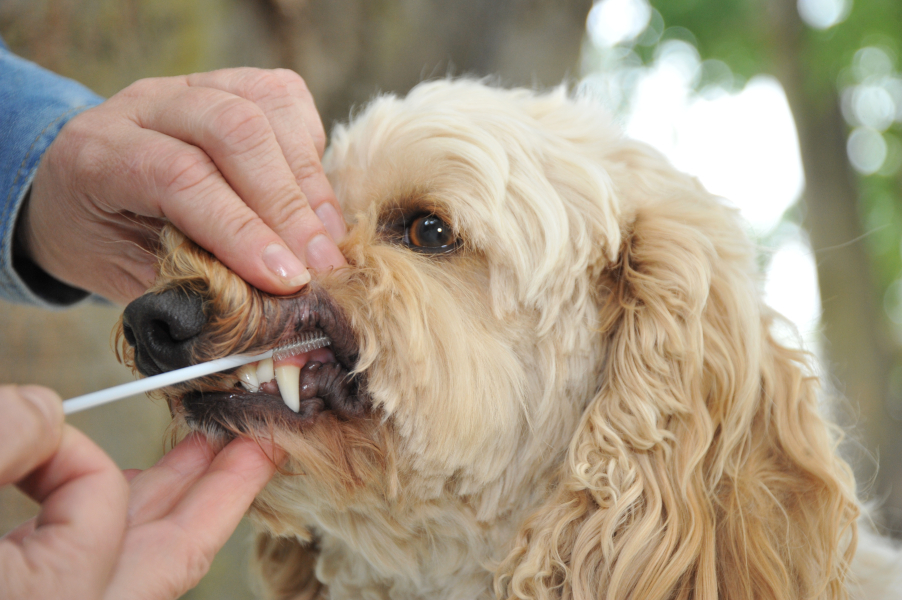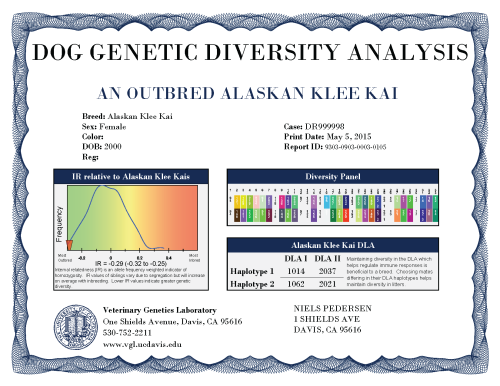Quick Summary
Introduction
The Veterinary Genetics Laboratory (VGL), in collaboration with Dr. Niels C. Pedersen and staff, has developed a panel of short tandem repeat (STR) markers that will determine genetic diversity across the genome and in the Dog Leukocyte Antigen (DLA) class I and II regions. This test panel is useful to breeders who wish to track and increase genetic diversity of their breed as a long term goal.
In order to evaluate a potential mating, the VGL case numbers of two diversity tested dogs can be input to a mating tool that calculates the genetic relatedness of the potential parents and simulates the offspring to give the expected and min/max internal relatedness (IR) values.
- Access Mating Tool (Requires MyVGL login)
The Canine Genetic Diversity Test includes the ISAG Panel, and parentage verification can be requested at no additional charge after diversity results are completed.
Currently this test is available for:
- Akita
- Alaskan Klee Kai
- American Hairless Terrier
- Berger Picard
- Bernese Mountain Dog
- Biewer
- Biewer Terrier
- Biewer Yorkshire Terrier
- Black Russian Terrier
- Borzoi
- Doberman Pinscher
- Flat-Coated Retriever
- German Pinscher
- Giant Schnauzer
- Golden Retriever
- Havanese
- Italian Greyhound
- Labrador Retriever
- Lakeland Terrier
- Llewellin Setter
- Miniature Poodle
- Newfoundland
- Polish Lowland Sheepdog
- Samoyed
- Scottish Collie
- Shiba Inu
- Shiloh Shepherd (ISSA)
- Shiloh Shepherd (non-ISSA)
- Standard Poodle
- Swedish Vallhund
- Toy Poodle
New Breed Enrollment / Research Phase
Genetic diversity testing using this same format can be directly applied to any breed. However, the most important tasks are to identify a cadre of breeders committed to diversity testing and to seek out all possible existing genetic diversity of the breed. (Read more about enrolling a breed in genetic diversity testing)
Breeds in Phase 2 - Preliminary Results/Research:
- American Eskimo Dog
- Barbet
- Border Collie
- Cardigan Welsh Corgi
- Chinook
- English Mastiff
- German Shepherd
- Great Dane
- Greater Swiss Mountain Dog
- Havana Silk
- Irish Setter
- Irish Red & White Setter
- Irish Wolfhound
- Magyar Agár
- Rat Terrier
- Saint Bernard
- Shikoku
- Whippet
Breeds in Phase 1 - Research:
- Afghan Hound
- Akbash Dog
- American Bully
- Australian Shepherd
- Beauceron
- Belgian Sheepdog (Groenendael, Laekenois, Malinois, Tervuren)
- Bouvier Des Flandres
- Boxer
- Chow Chow
- Collie
- English Shepherd
- English Springer Spaniel
- Eurasier
- Hokkaido
- Jack Russell Terrier
- Kai Ken
- Kishu Ken
- Mi-Ki
- Mudi
- Parson Russell Terrier
- Russell Terrier
- Saluki
- Staffordshire Bull Terrier
- Standard Schnauzer
- Weimaraner
Don't see your breed listed and want to enroll it? More information on how to enroll a breed is available here.
Please note, this test will not identify breed.
Sample Collection
Dog DNA tests are carried out using cells brushed from your dog's cheeks and gums. The preferred cytology brushes are sent to you by mail, or you may provide your own brushes. For accepted alternative brushes, click here
We recommend waiting until puppies are at least three weeks old before testing.

Step-By-Step:
- Make sure the dog has not had anything to eat or drink for at least 1 hour prior to collecting sample.
- When swabbing puppies, isolate each puppy from the mother, littermates and any shared toys for 1 hour prior to swabbing. Puppies should not have nursed or eaten for 1 hour prior to collecting sample.
- If collecting samples from more than one dog, make sure to sample one dog at a time and wash your hands before swabbing another dog.
- Label brush sleeve with name or ID of dog to be sampled.
- Open brush sleeve by arrow and remove one brush by its handle.
- Place bristle head between the dog’s gums and cheek and press lightly on the outside of the cheek while rubbing or rotating the brush back and forth for 15 seconds.
- Wave the brush in the air for 20 seconds to air dry.
- Insert brush back into sleeve.
- Repeat steps 5 - 8 for each unused brush in sleeve on a fresh area of cheek and gums. Make sure to use and return all brushes sent by the VGL. In most cases, it will be 3 brushes per dog. If using interdental gum brushes, please note that the VGL requires 4 brushes per dog and only moderate or wide interdental gum brushes are accepted.
- Do not seal brushes in sleeve.
- Place all samples in an envelope and return to the address provided.
ATTENTION:
- Do not collect saliva/drool – the key to obtaining a good sample is getting cheek cells on the swab
- Do not rub swab on the dog’s tongue or teeth – this will result in poor quality sample
- Do not collect a sample from a puppy that has recently nursed – the mother’s genetic material can rub off on the puppy’s mouth and contaminate the sample

